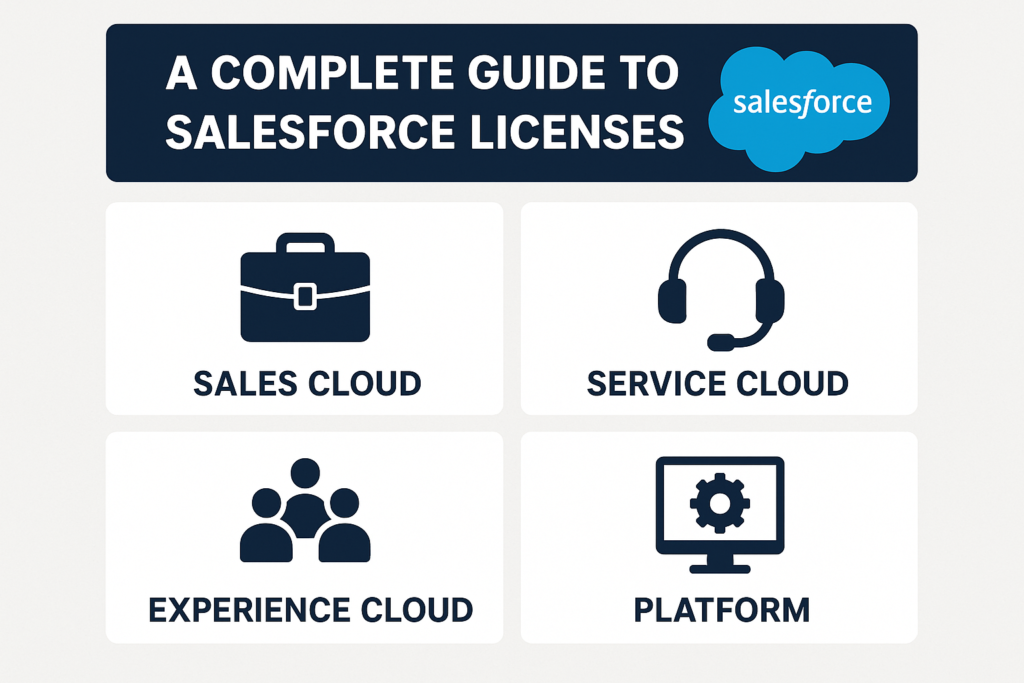📝 A Complete Guide to Salesforce Licenses
Salesforce is one of the most powerful CRM platforms in the world, but with great flexibility comes complexity — especially when it comes to licenses. If you’ve ever wondered:
-
“What’s the difference between a Salesforce license and a feature license?”
-
“Why does one user cost more than another?”
-
“How do I know if my company is overpaying?”
…this blog will give you clarity.
🔑 What is a Salesforce License?
A Salesforce license determines what features a user can access in your Salesforce org. Every user must have:
-
User License → defines the core platform access (Sales Cloud, Service Cloud, Platform, etc.)
-
Profile → defines permissions, objects, and fields accessible
-
Permission Sets (Optional) → grant additional rights beyond the profile
-
Feature Licenses (Optional) → unlock extra functionality (e.g., Knowledge, Marketing, CPQ)
👉 Think of a user license like a base subscription plan, while feature licenses are add-ons.
📌 Types of Salesforce Licenses
1. User Licenses (Base Licenses)
These define the main type of access a user gets. Common ones:
-
Salesforce License (Full CRM)
-
Best for Sales/Service users
-
Full access to standard CRM features (Accounts, Contacts, Leads, Opportunities, Cases)
-
Includes API access
-
-
Salesforce Platform License
-
Lighter & cheaper than full CRM
-
Access to custom apps and objects, but not Leads, Opportunities, or Cases
-
Ideal for back-office users (HR, Finance, Ops)
-
-
Chatter Free / Chatter Only (Chatter Plus)
-
Collaboration access without CRM data
-
Useful for users who only need to post, follow, and collaborate
-
-
Service Cloud License
-
Includes Service Console, Case Management, Knowledge Base
-
Designed for support agents
-
-
Community (Experience Cloud) Licenses
-
For external users (partners, customers, resellers)
-
Multiple flavors (Customer Community, Partner Community, Customer Community Plus)
-
2. Feature Licenses (Add-ons)
Feature licenses extend what a base license can do. Examples:
-
Marketing User → Allows running campaigns
-
Knowledge User → Create/manage Salesforce Knowledge articles
-
Service Cloud User → Enables Service Console and Case features
-
Live Agent User → Access to Live Chat
-
Einstein Analytics User → Access to Tableau CRM/Einstein Analytics
⚠️ Important: A feature license cannot exist alone — it must sit on top of a base license.
3. Permission Set Licenses (PSL)
-
Granular licenses that unlock features for specific users
-
Example: Salesforce CPQ PSL, Identity PSL, Inbox PSL
-
Helps avoid upgrading a whole user to a more expensive license
📊 Example Scenarios
-
Scenario 1: Sales Team
-
Needs Leads, Opportunities, Forecasting → Salesforce License
-
-
Scenario 2: Back-office HR Team
-
Only needs custom objects for HR requests → Platform License
-
-
Scenario 3: Knowledge Base Writers
-
Needs Knowledge Article Management → Salesforce License + Knowledge Feature License
-
-
Scenario 4: Customers logging into a portal
-
Only need to view cases & self-service → Customer Community License
-
💰 License Costs (High-level Idea)
(Exact pricing varies by contract — these are industry averages)
-
Salesforce (Enterprise Sales/Service Cloud): $150–$175/user/month
-
Platform: $25–$50/user/month
-
Chatter: Free or $15/user/month (Chatter Plus)
-
Community: Login-based or Member-based pricing
-
Add-ons (e.g., CPQ, Einstein, Pardot): Additional per-user cost
⚠️ Tip: Always check your Salesforce contract or reseller for actual prices.
📈 License Management Best Practices
-
Run a License Assessment Quarterly
-
Identify inactive/dormant users still holding expensive licenses
-
Use reports from Setup → Company Information
-
-
Right-Size Licenses
-
Don’t give full Salesforce licenses to users who only need Platform features
-
Example: Finance team may not need Opportunities, just custom objects
-
-
Leverage Permission Set Licenses
-
Instead of upgrading a user’s license, assign PSLs to unlock specific features
-
-
Use Communities (Experience Cloud) for External Users
-
Cheaper than giving them internal Salesforce licenses
-
-
Document License Allocation
-
Maintain a license inventory sheet mapping users → profiles → license type
-
🚀 Salesforce Optimizer for License Insights
Salesforce Optimizer (Setup → Optimizer) automatically scans your org and provides:
-
License utilization stats
-
Unused profiles and permission sets
-
Feature adoption reports
👉 Always download the Optimizer report before renewing Salesforce contracts — it can save thousands in unnecessary license spend.
✅ Key Takeaways
-
User License = Base Access (Salesforce, Platform, Service Cloud, etc.)
-
Feature License = Add-on Access (Knowledge, Marketing, Live Agent)
-
Permission Set License = Granular Unlock (CPQ, Identity, Inbox)
-
Right-sizing licenses = Major cost savings
-
Quarterly license assessments prevent waste and compliance issues
🏁 Final Thoughts
Salesforce licenses can be tricky, but if managed well, they ensure your users have just the right access at the right cost.
Whether you’re an Admin optimizing usage, a CFO looking at cost savings, or a business leader planning growth, understanding Salesforce licenses is essential.

